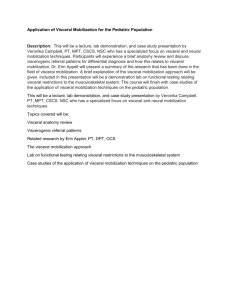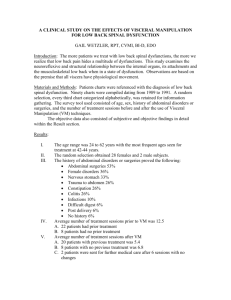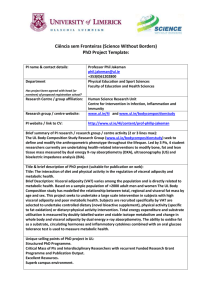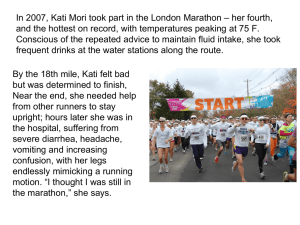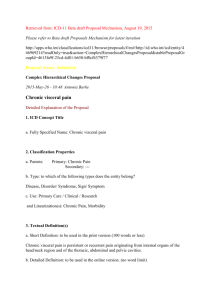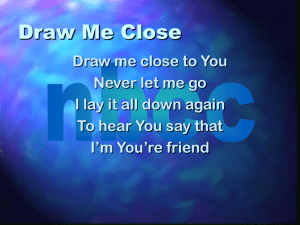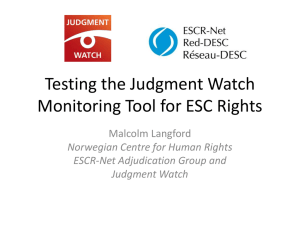Choices, Judgments, and Temperature: From Visceral States to
advertisement
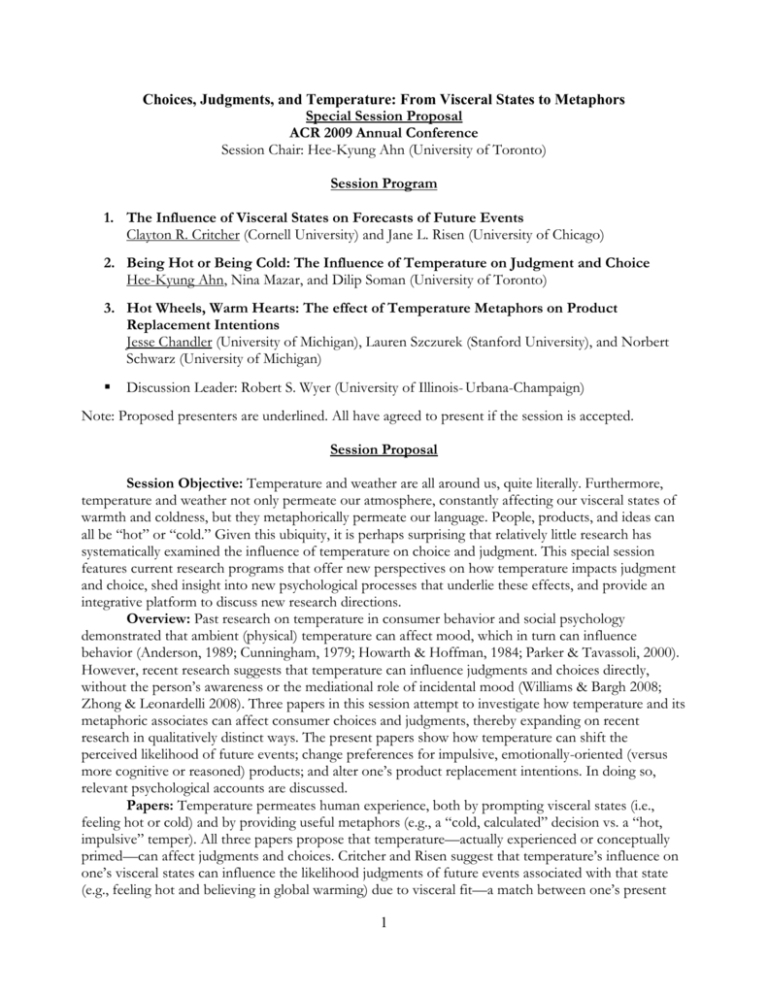
Choices, Judgments, and Temperature: From Visceral States to Metaphors Special Session Proposal ACR 2009 Annual Conference Session Chair: Hee-Kyung Ahn (University of Toronto) Session Program 1. The Influence of Visceral States on Forecasts of Future Events Clayton R. Critcher (Cornell University) and Jane L. Risen (University of Chicago) 2. Being Hot or Being Cold: The Influence of Temperature on Judgment and Choice Hee-Kyung Ahn, Nina Mazar, and Dilip Soman (University of Toronto) 3. Hot Wheels, Warm Hearts: The effect of Temperature Metaphors on Product Replacement Intentions Jesse Chandler (University of Michigan), Lauren Szczurek (Stanford University), and Norbert Schwarz (University of Michigan) Discussion Leader: Robert S. Wyer (University of Illinois- Urbana-Champaign) Note: Proposed presenters are underlined. All have agreed to present if the session is accepted. Session Proposal Session Objective: Temperature and weather are all around us, quite literally. Furthermore, temperature and weather not only permeate our atmosphere, constantly affecting our visceral states of warmth and coldness, but they metaphorically permeate our language. People, products, and ideas can all be “hot” or “cold.” Given this ubiquity, it is perhaps surprising that relatively little research has systematically examined the influence of temperature on choice and judgment. This special session features current research programs that offer new perspectives on how temperature impacts judgment and choice, shed insight into new psychological processes that underlie these effects, and provide an integrative platform to discuss new research directions. Overview: Past research on temperature in consumer behavior and social psychology demonstrated that ambient (physical) temperature can affect mood, which in turn can influence behavior (Anderson, 1989; Cunningham, 1979; Howarth & Hoffman, 1984; Parker & Tavassoli, 2000). However, recent research suggests that temperature can influence judgments and choices directly, without the person’s awareness or the mediational role of incidental mood (Williams & Bargh 2008; Zhong & Leonardelli 2008). Three papers in this session attempt to investigate how temperature and its metaphoric associates can affect consumer choices and judgments, thereby expanding on recent research in qualitatively distinct ways. The present papers show how temperature can shift the perceived likelihood of future events; change preferences for impulsive, emotionally-oriented (versus more cognitive or reasoned) products; and alter one’s product replacement intentions. In doing so, relevant psychological accounts are discussed. Papers: Temperature permeates human experience, both by prompting visceral states (i.e., feeling hot or cold) and by providing useful metaphors (e.g., a “cold, calculated” decision vs. a “hot, impulsive” temper). All three papers propose that temperature—actually experienced or conceptually primed—can affect judgments and choices. Critcher and Risen suggest that temperature’s influence on one’s visceral states can influence the likelihood judgments of future events associated with that state (e.g., feeling hot and believing in global warming) due to visceral fit—a match between one’s present 1 visceral state and a future state of the world that would cause that visceral state. Furthermore, they demonstrate that merely priming the concepts of “warmth” did not have analogous effects. In the second paper, Ahn, Soman, and Mazar examine how variations in both physical and primed temperature can lead to different decisions due to temperature’s metaphoric relation to two different psychological states (i.e., impulsive = hot, calculated = cold). Across a series of studies they show that people exposed to literal or conceptual (primed) heat are more likely to be impatient and impulsive in their judgments and decision making, whereas coldness elicits a relatively more distanced and rational approach. In the third paper, Chandler, Szczurek, and Schwarz demonstrate that when consumers are primed to think of products in anthropomorphic terms, temperature metaphors can heavily influence consumers’ product replacement intentions. People feel “warmth” for other humans, but do people feel similar “warmth” for inanimate products? When first led to anthropomorphize their cars, people primed to view their car’s appearance in “warm” (versus “cold”) terms stated their intention not to replace their cars, regardless of its current quality. Contribution and Likely Audience: These papers apply novel perspectives in understanding the relationship between temperature and judgment and decision making. Critcher and Risen’s notion of visceral fit; Ahn et al.’s dual links between temperature concepts and mental states; and Chandler et al.’s anthropomorphic approach to consumer behavior, all reflect new approaches that both account for the findings presented here and can be used to generate a host of new hypotheses relevant to consumer behavior. Furthermore, differences between these papers also raise new questions of interest in themselves. For example, Critcher and Risen found that visceral states, but not related conceptual primes, influenced judgment. In contrast, Ahn et al. found their effects both by influencing actual visceral states and by merely priming related concepts. This discrepancy raises a heretofore underexplored topic in this literature that is crucial for predicting when these documented effects will emerge: Under what conditions can merely priming visceral states, as opposed to experiencing the visceral states, yield (dis)similar consequences on consumers’ judgments and choices? Finally, Chandler et al. show that how temperature metaphors influence product evaluations depends on how much consumer have anthropomorphized the target product. This suggests an important boundary condition on these effects. Researchers and practitioners must be sensitive to how consumers construe a target consumer product to understand whether and how temperature will influence judgments of it. All papers include multiple completed studies that have not been presented at ACR before. The session is structured in an interdisciplinary manner with behavioral decision research and social psychology as backgrounds, and should appeal to researchers interested in consumer information processing and judgment and decision making more broadly. Finally, we believe that Professor Robert Wyer, who is an expert in the area, will provide constructive comments on the presented papers, suggest future research directions, and synthesize the comments from the audience during the last 15 minutes of the session. EXTENDED ABSTRACTS The Influence of Visceral States on Forecasts of Future Events Clayton R. Critcher (Cornell University) and Jane L. Risen (University of Chicago) Should one stock up on water in order to weather a future water shortage? Is it wise to invest in a more efficient cooling system for one’s house in anticipation of global warming? The answers to these and related questions require one to look into the future and make forecasts about the likelihood of different future states. Desertification is a growing problem, and residents of many communities must decide whether the trend is serious enough that they should take steps to preemptively avert disaster. The release and success of Al Gore’s An Inconvenient Truth made 2 the public bluntly aware of the problems associated with global warming, but skepticism still abounds about whether global warming is a veritable concern, or “just a theory.” In looking to the future to answer these questions, one would think (or hope) that people would look to experts to assess the likelihood that these consumer-impactful states would befall us. Although the dissemination of scientific knowledge no doubt informs some people, we propose that one’s current visceral states may play a surprising role in guiding belief in the likelihood of these future possibilities. Past psychological research has found that visceral states (e.g., thirst, warmth, hunger) can influence judgments by one of three pathways. First, experiencing a visceral state can be an indirect means to prime related concepts (Williams & Bargh, 2008). Second, the experience of a visceral state can moderate the effect of a conceptual prime. For example, a thirst prime only leads people to drink more when they are experiencing the visceral state of thirst (Strahan, Spencer, & Zanna, 2002, 2005). Finally, the experience of a visceral state can help one appreciate the power of a visceral state. For example, Nordgren, van der Pligt, and van Harreveld (2007) found that people were more willing to excuse the offensive behavior of a fatigued parent when the participants were fatigued themselves, presumably because they could better understand how fatigue could lead one to behave uncharacteristically. We propose a fourth possibility, that when there is a visceral match between one’s current visceral state and the visceral state that one would experience if a future state occurred, people believe it is more likely that these future states will occur. Four studies examine this hypothesis by testing whether those who experience a visceral state—warmth or thirst—are more likely to predict that there is convincing evidence in support of related phenomena—global warming or future water shortages, respectively. Study 1 was conducted outdoors. Participants expressed their attitudes on a number of political and policy-related issues. One of the items related to global warming. The question wording was adopted from a recent CNN poll. Participants indicated to what extent participants believed that global warming was “a proven fact” or “a theory that has yet to be proven.” While participants answered these questions, the experimenter recorded the outdoor temperature. Belief that global warming was a proven reality was significantly predicted by the outdoor temperature ß = .24, t(63) = 2.04, p = .05. Of course, it is possible that the participants were simply inappropriately inferring a long-term weather pattern from the temperature at that specific moment, and that their experience of warmth was not important. To rule out this explanation, we moved Study 2 indoors, such that we could manipulate participants’ experience of warmth without providing any information about the actual weather. We found that those participants randomly assigned to state their belief in global warming in a 27C (81F) room expressed greater belief in global warming than did those who stated their belief in a 23C (73F) room. We do not claim that our effects emerge because visceral states merely conceptually activate a related visceral state concept (e.g., Williams & Bargh, 2008), which then influences one’s judgments. In other words, we do not believe that our effects are mediated by the conceptual activation of the concept warmth. To more conclusively rule out conceptual activation as a mediator of our effects in Study 3, we primed some participants conceptually with “warmth”, using a sentence-unscrambling task. We found that this priming task did lead participants to complete incomplete letter strings with warmth-related words (confirming that the concept of warmth was indeed primed), but belief in global warming was unaffected. In a final study, we moved to a new visceral state—thirst—and a new judgment—belief that the American Southwest would soon hit “peak water,” which would lead to water shortages in the region. Participants were randomly assigned to a condition in which they were made thirsty by eating pretzels (visceral condition), primed subliminally with the concept thirst (prime condition), or neither (control 3 condition). Then participants watched a video explaining the debate over whether the American Southwest would soon reach “peak water.” A word-completion task found that those in the visceral and prime condition, compared to those in the control, had thirst-related concepts conceptually active. But only participants in the visceral condition actually became more convinced after watching the video that peak water would soon be reached. These studies reflect a theoretically novel pathway by which visceral states can influence judgment. Just as the conceptual accessibility of a statement may lead it to be processed with enhanced conceptual fluency, leading to an inference of validity (see Schwarz, Sanna, Skurnik, & Yoon, 2007), we believe that the visceral fit between one’s experience and a considered state of the world may lead it to be simulated with enhanced “visceral fluency,” leading to a similar inference of validity (see Cesario & Higgins, 2008, for a similar “fit” argument). Although many psychological biases are studied in contexts in which people are led astray, we have intentionally studied visceral fit in contexts in which these “biases” actually pushed people toward expert-endorsed opinions. Thus, although it is non-normative to rely on visceral states in the ways demonstrated here, these effects are not inherently helpful or harmful. Even though visceral fit may at times lead participants’ judgments astray, the principle can also be harnessed to enhance the power of expert-endorsed communication. Being Hot or Being Cold: The Influence of Temperature on Judgment and Choice Hee-Kyung Ahn, Nina Mazar, and Dilip Soman (University of Toronto) Temperature is a very familiar concept to most consumers. It not only describes our physiological degree of comfort, but it also metaphorically permeates our language. People, products, and ideas can all be “hot” or “cold.” For instance, temperature-related words such as “hot” and “cold” are often used to describe impulsive and calculated behaviors, respectively. In a similar vein, our languages are replete with expressions such as “he has a hot temper,” “what a cold, unfeeling person she was,” and “the media, meanwhile, has blown hot and cold on the affair.” In these expressions, “hot” and “cold” are interpreted through metaphoric meanings rather than as direct thermal concepts. Furthermore, even though relatively little research has systematically examined the influence of temperature on choice and judgment, psychologists as well as behavioral decision researchers often use the thermal concept “hot,” (vs. “cold”) to describe impulsive behaviors metaphorically (Loewenstein 1996; Metcalf and Mischel 1999; Peters et al. 2005). These metaphoric associations of thermal concepts raise the question as to whether temperature and psychological states are related to each other, and if so, how. In this research, we examine three research questions; (1) what is the effect of temperature on choice and judgment, especially in the domain of impulsive behaviors? (2) Do these effects of temperature persist when the concept of temperature is primed rather than experienced? (3) What could be a theoretical approach that explains these effects? To address these questions, we have conducted a series of field and laboratory experiments and have found support for a relationship between temperature and impulsivity. We operationalize impulsive behaviors by measuring a) willingness to pay [WTP] for products, b) preferences for a smaller–sooner [SS] reward over a larger–later [LL] one, c) preferences for a short term bank deposit over long term bank deposit, d) preferences for a risky gamble over a less risky gamble, and e) the errors made in answering a quiz where the intuitive answer is different from the calculated one. Across five studies, we demonstrate that the actual experiences of ambient temperature trigger decision outcomes in line with the metaphoric association between temperature and impulsivity. When people 4 are hot, they become more impulsive than when they are cold. Moreover, these temperature effects persist when the concept of temperature is primed by temperature-related words and pictures. In the pilot (field) study, we find evidence that temperature can influence participants’ WTP judgments. WTP measures for a number of product categories were significantly higher when measured in a hot spa room than in a cold spa room. To examine whether the effect of this metaphoric link persists in the extreme temperature condition, we conducted study 1 at a spa adding one more experimental condition (i.e., an extremely hot spa room). Study 1 supported the notion that the link between temperature and impulsivity may not persist in extremely hot temperatures. We also obtained evidence to support the influence of temperature on choices. In the subsequent studies, we replicated the effects of temperature on WTP judgments and choices by using temperature primes such as slideshows of seasonal pictures (study 2) and scrambled sentence tasks (study 3). In addition, we tested the metaphorical link between hotness and impulsivity using various concepts of impulsivity including impatience (study 1, 2, and 3), risk taking (study 2), and decision time (study 4). In sum, participants in the hot (vs. cold) condition indicated a higher WTP for target products and were more likely to choose relatively impulsive options such as a 1-year bank term deposit, a risky gamble, a smaller but sooner [SS] reward, and an incorrect answer to the target problem. Finally, we manipulate temperature by using hot and cold therapeutic packs to examine whether the simultaneous experiences (activations) of hot and cold temperatures wipe out the temperature association effect. We developed four conditions including hot packs only, cold packs only, one hot/one cold pack, and no pack (control) conditions. The results of study 4 revealed that the simultaneous experiences of hot and cold temperatures result in a similar pattern of judgments and choices as the control condition, in which temperature was not manipulated. The findings rule out a couple of alternative explanations; studies show that mood and arousal do not explain the effects of temperature on WTP and choice. We suggest that the theories of embodied cognition provide an explanation for these findings. This theory suggests that processing of abstract concepts involves embodiment; where embodiment refers both to actual bodily states and simulations of experience in the brain’s modality-specific systems for perception, action, and introspection (Barsalou 1999; Lakoff and Johnson 1999; Neidenthal et al. 2005). For example, a recent study by Zhong and Leonardelli (2008) suggests that the linguistic coupling between social isolation and coldness may reflect a person’s predisposition to use concepts that are based on bodily experience (e.g., coldness) to describe complex concepts such as social rejection. Consistent with this view, the current findings demonstrate that not only actual experiences of temperature, but also temperature primes which simulate experience can influence subsequent choice and judgment. While recent work on the effect of temperature has focused on actual temperature and its direct consequences (mood, cognition, and behaviors), our findings take this insight a step further by demonstrating that the metaphoric link between temperature concepts (temperature primes as well as actual temperature) and impulsivity can influence judgments and choices. This work demonstrates the robustness of temperature effects on judgment and choice by examining the effect across various constructs of impulsivity, product categories, and dependent variables. This research implies that the activation of the hot-impulsivity link may influence various aspects of consumer behavior varying from risk taking to excessive reliance on intuition in addition to the delay of gratification (Ainslie 1975; Metcalfe and Mischel 1999). The results also have practical implications for packaging, advertising, merchandising and pricing; as well as for public policy and awareness. 5 Hot Wheels, Warm Hearts: The Effect of Temperature Metaphors on Product Replacement Intentions 1 Jesse Chandler , Lauren Szczurek2, and Norbert Schwarz1(1 University of Michigan, 2Stanford University) Judgments of interpersonal warmth produce striking and consistent differences in the perception of others. Information signaling warmth can come from many sources, including meaning laden personality descriptions (Asch, 1946), irrelevant semantic primes (Scholer & Higgins, 2008) and ambient temperature cues (Zhong & Leonardelli 2008). Despite the varied sources of temperature information, its influence is quite specific and theory-driven. Generally speaking, people described as “warm” are perceived more positively. However, the influence of temperature metaphors cannot be explained as a simple halo effect – connotations of warmth primarily influence evaluations of interpersonal characteristics and can even reduce the likelihood that some positive traits, such as strength and persistence, come to mind (Asch, 1946). Moreover, the evaluative consequences of temperature metaphors depend on other accessible information about the target such as co-occurring personality traits; under different circumstances “cold” can mean either aloof or ruthless (Asch, 1946). Together, these findings suggest that that temperature is integrated with other social knowledge to make specific inferences about the target of judgment rather than simply promoting a diffuse positive feeling. The meaning of metaphorical warmth may depend on the domain of judgment. Outside of the social realm, metaphorical connotations of warmth and cold may not matter, or may carry different meanings entirely: connotations of warmth differ when the target of judgment is a close friend or a refrigerator. However, what belongs within the social realm is itself ambiguous, and sometimes people treat objects as if they are alive (for a review see Epley, Waytz & Cacioppo, 2007). For example, people are less willing to replace anthropomorphized objects (Chandler & Schwarz, 2008), prefer anthropomorphized objects that display prosocial cues (smiling; Aggarwal & McGill, 2007) and spontaneously apply social knowledge structures when describing or interacting with objects (Heider & Simmel, 1944; Nass & Moon, 2000). The influence of temperature metaphors on the perception of products may likewise mirror the influence of temperature metaphors on person perception when people think about objects in anthropomorphic terms. To test this hypothesis, we examine whether i) connotations of warmth and cold influence people’s intentions to replace their car and ii) whether this influence depends upon the accessibility of anthropomorphic beliefs. Participants were recruited for an online experiment about their cars. To manipulate the warm or cold connotations of the car, participants selected the color that most closely resembled their car’s color from a matrix of nine colored squares and remembered the color’s label as a part of a “memory task”. Depending on condition, the five most common car colors were labeled with “warm” (e.g. “summer blue”) or “cold” (e.g. “blizzard blue”) names. Thus, both warm and cold concepts were equally accessible to all, but only one was applicable to judgments about their car. All participants saw a mixture of “warm” and “cold” color names along with four less common colors given distracter labels (e.g. “canary yellow”). Next, participants were randomly assigned to rate their car along 5 scales anchored with adjectives that implied either psychological (e.g. “reserved” to “enthusiastic”) or physical features (e.g. “quiet” to “loud”); a control group did not provide ratings. Participants then described their car in their own words, indicated their desire to replace their car, and reported the name assigned to the color of their car (thus completing the memory task). These manipulations resulted in a 2 (warm vs. cold color labels) x 3 (psychological vs. physical features vs. control)-factorial between-participants design in which the car’s temperature was purely symbolic (stripped of the physical sensation of warmth/cold), arbitrary (not dependant on the actual color of the car), and randomly assigned. 6 Replicating previous research, we find that participants who described their car negatively were more willing to replace it, except when psychological features of the car were accessible (Chandler & Schwarz, 2008). Although participants were more willing to replace poor quality than high quality cars in the physical feature and control conditions, this relationship vanished in the psychological feature (anthropomorphization) condition: A desire to keep their current cars was uniformly high for this group. We further find that people were particularly unwilling to replace anthropomorphized cars when their color had been associated with warm rather than cold labels. In contrast, color labels did not influence participants’ replacement willingness in the physical features and control conditions. Other experiments extend this logic by examining other contexts in which metaphorical connotations of warmth and cold influenced preferences for products. For example, we find that consumers’ preferences for metaphorically warm and cold objects depend upon such products’ intended use. Consumers rated notebooks with warm color names (e.g. “summer sky”) as more desirable after being asked about personal uses for notebooks, and notebooks with cold color names (e.g. “blizzard blue”) as more desirable after being asked about school uses for notebooks. Taken together, these findings indicate that warm and cold metaphorical connotations influence how consumers perceive objects, but that the consequences of these connotations on judgment differ depending on both the category to which the object is assigned and its function. This line of research identifies important boundary conditions of the effects of warm and cold connotations, and has implications for how we portray objects that are imbued with agentic qualities or have social uses. References Aggarwal, P., & McGill, A. L. (2007). Is that car smiling at me? Schema congruity as a basis for evaluating anthropomophized products. Journal of Consumer Research, 34, 468-479. Ainslie, G. (1975). Specious reward: A behavioral theory of impulsiveness and impulse control. Psychological Bulletin, 82 (4), 463-495. Anderson, C. A. (1989). Temperature and aggression: Ubiquitous effects of heat on occurrence of human violence. Psychological Bulletin, 106 (1), 74-96. Asch, S. E. (1946). Forming impressions of personality. Journal of Abnormal and Social Psychology, 41, 258290. Barsalou, L. W. (1999). Perceptual symbol systems. Behavioral and Brain Sciences, 22 (August), 577-660. Cesario, J., & Higgins, E. T. (2008). Making message recipients “feel right”: How nonverbal cues can increase persuasion. Psychological Science, 19, 415-420. Chandler, J., & Schwarz, N. (Feb, 2008). Looking on the byte side of life: The cognitive and emotional consequences of thinking of computers as alive. Poster presented at the Society for Personality and Social Psychology Annual Convention, Albuquerque, NM Cunningham, M. R. (1979). Weather, mood, and helping behavior: Quasi-experiments with the sunshine Samaritan. Journal of Personality and Social Psychology, 37 (11), 1947-956. Epley, N., Waytz, A., & Cacioppo, J. T. (2007). On seeing human: a three-factor theory of anthropomorphism. Psychological Review, 114, 864–886. Heider, F. and Simmel, M. (1944) An experimental study of apparent behavior. American Journal of Psychology, 57, 243–249. 7 Howarth, E., & Hoffman. M. S. (1984). A multidimensional approach to the relationship between mood and weather. British Journal of Psychology, 75 (1), 15-23. Lakoff, G., & Johnson, M. (1999). Philosophy in the flesh: The embodied mind and its challenge to Western thought. New York: Basic Books. Loewenstein, G. (1996). Out of control: Visceral influences on behavior. Organizational Behavior and Human Decision Processes, 65 (3), 272-92. Metcalfe, J., & Mischel, W. (1999). A hot/cool-system analysis of delay of gratification: Dynamics of willpower. Psychological Review, 106 (1), 3-19. Nass, C., & Moon, Y. (2000) Machines and mindlessness: social responses to computers. Journal of Social Issues, 56, 81-103. Neidenthal, P. M., Barsalou, L. W., Winkielman, P., Krauth-Gruber, S., & Ric, F. (2005). Embodiment in attitudes, social perception, and emotion. Personality and Social Psychology Review, 9 (3), 184-211. Nordgren, L. F., van der Pligt, J., & van Harreveld, F. (2007). Evaluating Eve: Visceral states influence the evaluation of impulsive behavior. Journal of Personality and Social Psychology, 93, 75-84. Parker, P. M., & Tavassoli, N. T. (2000). Homeostasis and consumer behavior across cultures. International Journal of Research in Marketing, 17, 33-53. Peters, E., Vastfjall, D., Garling, T., & Slovic, P. (2006). Affect and decision making: A hot topic. Journal of Behavioral Decision Making, 19, 79-85. Scholer, A., & Higgins, E. T. (2008). People as resources: Exploring the functionality of warm and cold. European Journal of Social Psychology, 38, 1111-1120. Schwarz, N., Sanna, L. J., Skurnik, I., & Yoon, C. (2007). Metacognitive experiences and the intricacies of setting people straight: Implications for debiasing and public information campaigns. Advances in Experimental Social Psychology, 39, 127-161. Strahan, E. J., Spencer, S. J., & Zanna, M P. (2002). Subliminal priming and persuasion: Striking while the iron is hot. Journal of Experimental Social Psychology, 38, 556-568. Strahan, E. J., Spencer, S. J., & Zanna, M P. (2005). Subliminal priming and persuasion: How motivation affects the activation of goals and the persuasiveness of messages. In F. R. Kardes, P. M. Herr, & J. Nantel (Eds.) Applying Social Cognition to Consumer-Focused Strategy (pp. 267-281). Mahwah, New Jersey: Lawrence Erlbaum Associates. Williams, L. E., & Bargh, J. A. (2008). Experiencing physical warmth promotes interpersonal warmth. Science, 322, 606-607. Zhong, C., & Leonardelli, G. (2008). Cold and lonely: Does social exclusion literally feel cold? Psychological Science, 19, 838-842. 8

